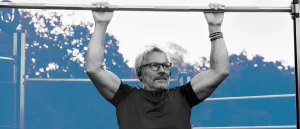This 10-Second Balance Test Is Linked to a Longer Life. Can You Pass?
Whether you’re a seasoned athlete or a new grandparent, balance plays a role in everything you do.
At best, it supports you through workouts, long shifts on your feet, and everyday chores. It might also be linked to a longer life, according to a study published in the British Journal of Sports Medicine (1).
For people over 50 years old, not being able to stand on one foot for 10 seconds was associated with a higher risk of death from any cause within the next seven years, per the study.
“Aged people falling are in very high risk of major fractures and other related complications,” said the study’s lead author, Dr. Caludio Gil Soares de Araújo. “This may play a role in the higher risk of mortality.”
Of the 1,700 adults in the study, 20 percent didn’t pass the test. Here’s what researchers found, how to do the test at home, and exercises to improve your balance.
The Balance Test
To explore whether a balance test might reveal insight into a person’s risk of death, Araújo and his team asked participants to stand on one leg for 10 seconds without holding onto anything to support themselves.
The participants, who were allowed three tries, were instructed to take off their socks and shoes, rest the front of their elevated foot on the back of their standing leg, and keep their arms at their sides and head straight forward.
Overall, one in five failed the test.
How Balance Predicts Longevity
The inability to pass the test rose with age, according to the researchers. In general, people who failed tended to be in poorer health than those who passed—with a higher proportion of people with obesity, cardiovascular disease, unhealthy blood cholesterol levels, and type 2 diabetes.
What’s more, the risk of death within seven years was almost two times (1.84 times to be exact) higher in participants who failed the 10-second balance test.
How to do the 10-Second Balance Test
Can you pass the test? Here’s exactly how to do the 10-second single-leg stance balance test at home.
- Stand upright, with your feet together, and your hands down at your sides. Have a stable object within reach, should you become unsteady during the test.
- Lift one foot off the ground. Keep the bottom of that lifted foot at least 12 inches off the ground. Keep your arms down at your sides and fix your gaze straight ahead.
- Count the seconds you’re able to stand in this one-legged position without lifting your arms or lowering your raised foot to the ground.
- Repeat the test three times and take the average of the three times to calculate your score.
Exercises to Improve Balance
“It is never too late to improve balance by specific training. A couple of minutes a day—at home or in the gym—can help a lot,” Araújo said.
Strength training can directly improve balance and stability (2, 3). It can add years to your life (1), help maintain and build muscle mass (4), reduce your risk of osteoporosis (5), and improve your neuromuscular connection (6)—for better control over your body.
Unilateral exercises, or exercises that focus on one side of your body at a time, are king for building postural strength and stability. However, it’s important to build strength in more stable positions (like squats) before moving on to single-sided variations (like lunges or step-ups).
Here are eight exercises to build strength, which directly translate to better balance.
Bodyweight Squat
How To Do It
- Start with feet shoulder-width apart, and toes pointed slightly out.
- Push your hips back, as if sitting in a chair. Lower yourself until your hips are parallel to the ground.
- Drive through your heels to stand, flexing your quads and glutes to finish.
Why It Improves Balance
Bodyweight squats are one of the best exercises to build strength in your legs, glutes, and core. They help build functional mobility to sit and stand with confidence throughout the day.
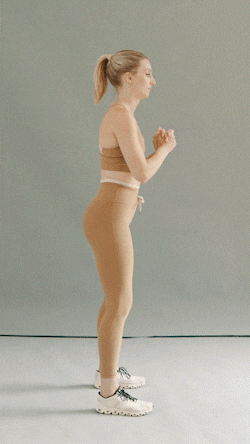
Reverse Lunges
How To Do It
- Start by taking a long stride backward with your right leg.
- Firmly plant your toe down, then lower yourself until your left thigh is parallel to the floor.
- Your upper and lower leg should form a 90-degree angle, on both your right and left leg. Take note of your body position, and adjust your next step if needed.
- Push through with your left heel to come back up, and bring your right leg forward to meet your left, flexing your glute to finish.
- Repeat on the other leg.
Why It Improves Balance
Lunges are a unilateral exercise that build single-sided strength and mobility in your quads, glutes, and hamstrings—strength that is highly transferable to everyday activities like walking and running.
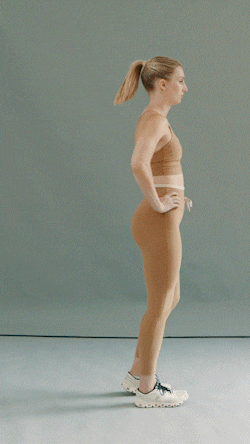
Lateral Lunges
How To Do It
- Begin with your feet together, then take a wide step out to your left, firmly plant your left foot on the ground and bend your left knee.
- Push back with your hips as if you’re sitting in a chair.
- Push off your left foot and return to the starting position.
- Repeat, alternating sides.
Why It Improves Balance
Everyday life doesn’t happen in just one plane of motion (forward and back). That’s why it’s important to train in all ranges of motion—including side-to-side and rotational movements. Side lunges help to strengthen the inner thighs (adductors) and the glute medius which helps counteract side-to-side wobbles when standing.
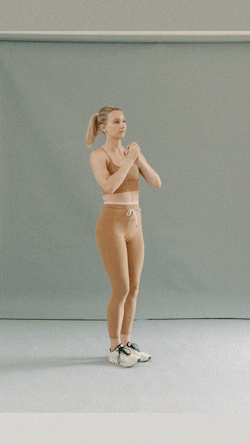
Walking Lunges
How To Do It
- Stand up straight with your feet shoulder-width apart. Leave your hands at your side, or rest them on your hips.
- Step forward with your right leg, putting the weight into your heel. Bend your right knee, lowering it until it’s parallel to the floor.
- Your upper and lower legs should form a 90-degree angle, on both your right and left leg.
- Take note of your body position, and adjust your next step if needed.
- Push through with your right heel to come back up, and bring your left leg forward, flexing your glute to finish.
- Step forward with your left leg, repeating the movement on the left side.
- Repeat this movement, walking forward as you lunge.
Why It Improves Balance
You’ll need to work up to walking lunges by perfecting your forward and reverse lunges first. Once you do, you’ll be prepared to take on this advanced variation which increases your strength and stability to shift from one foot to the other with confidence.
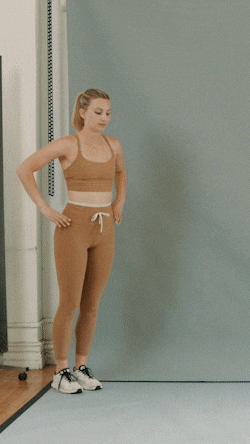
Step Ups
How To Do It
- Start by placing your foot on a low step, box, or bench.
- Keeping your chest tall and core tight, lean into the heel of the front leg and push off of it to step up.
- Flex your quad and glute at the top of the movement, then lower yourself with control before performing another rep.
Why It Improves Balance
Step-ups are perfect for building single-sided strength. By working on two different levels, this exercise amps up the challenge on your quads, hamstrings, and glutes. Start with a lower step. You can advance to a higher one once you build confidence and strength.

Hip Thrust
How To Do It
- Start seated on the floor in front of a weight bench, knees bent, and feet shoulder-width apart.
- Your upper back should be resting against the middle edge of the weight bench.
- Press through your heels and squeeze your glutes to press your hips up until they’re in line with your shoulders and knees.
- Slowly lower until your hips are a few inches off the floor.
Why It Improves Balance
Hip thrusts are one of the best exercises to increase glute strength. Your glutes are powerful muscles in the backside of your body that support your pelvis—strengthen them, and you’re one step closer to better balance.
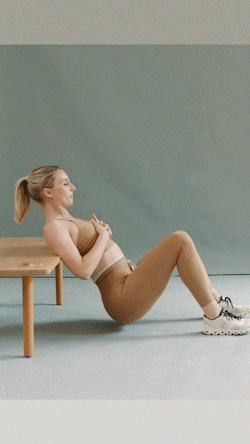
Single Leg Hip Thrust
How To Do It
- Start seated on the floor in front of a weight bench, knees bent, and feet shoulder-width apart. Your upper back should be resting against the middle edge of the bench.
- Lift one leg off the ground, keeping your hips and core tight so your body doesn’t shift towards your supporting leg.
- Press through your supporting heel and squeeze your glutes to press your hips up until they’re in line with your shoulders and knees.
- Slowly lower until your hips are a few inches off the floor, and repeat.
Why It Improves Balance
The unilateral version of the hip thrust puts the emphasis on one glute at a time. Building up your strength on each side helps to correct imbalances, reinforcing stability.
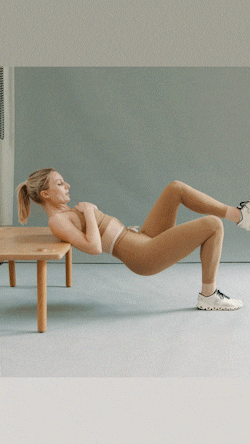
Deadbugs
How To Do It
- Lie face up with knees bent at 90 degrees, and stacked over your hips. Straighten your arms and extend above you, aligning your hands with your shoulders.
- Extend your left leg out straight, simultaneously extending your right arm overhead. Move with control, keeping your lower back pressed into the floor until both are hovering a few inches over the ground.
- Bring your arm and leg back to the starting position.
- Repeat on the other side, extending your right leg and left arm.
.
Why It Improves Balance
Deadbugs teach you to effectively move opposing limbs in tandem while keeping your core stable and your back protected, a skill helpful during everyday tasks like walking, carrying groceries, or climbing the stairs.
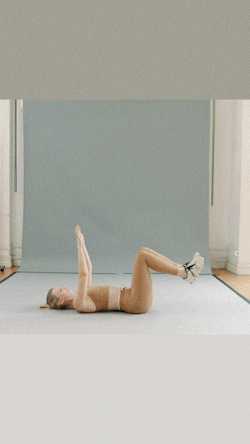
References
1. Coleman, C. et al (2022). Dose-response association of aerobic and muscle-strengthening physical activity with mortality: a national cohort study of 416 420 US Adults. https://bjsm.bmj.com/content/56/21/1218
2. Lee, I. et al (2013). Balance Improvement by Strength Training for the Elderly. https://www.ncbi.nlm.nih.gov/pmc/articles/PMC3885846/
3. Sarabon, N. et al (2020). Effects of Resistance Exercise on Balance Ability: Systematic Review and Meta-Analysis of Randomized Controlled Trials. https://pdfs.semanticscholar.org/6cc2/d01edfd2887899dedcdbca844f792dfe757e.pdf
4. Santana, D. et al (2021). Strength Training Volume to Increase Muscle Mass Responsiveness in Older Individuals: Weekly Sets Based Approach. https://www.frontiersin.org/articles/10.3389/fphys.2021.759677/full
5. Hong, A. et al (2018). Effects of Resistance Exercise on Bone Health. https://www.ncbi.nlm.nih.gov/pmc/articles/PMC6279907/
6. Herold, F. et al (2019). Functional and/or structural brain changes in response to resistance exercises and resistance training lean to cognitive improvements—a systematic review. https://eurapa.biomedcentral.com/articles/10.1186/s11556-019-0217-2









